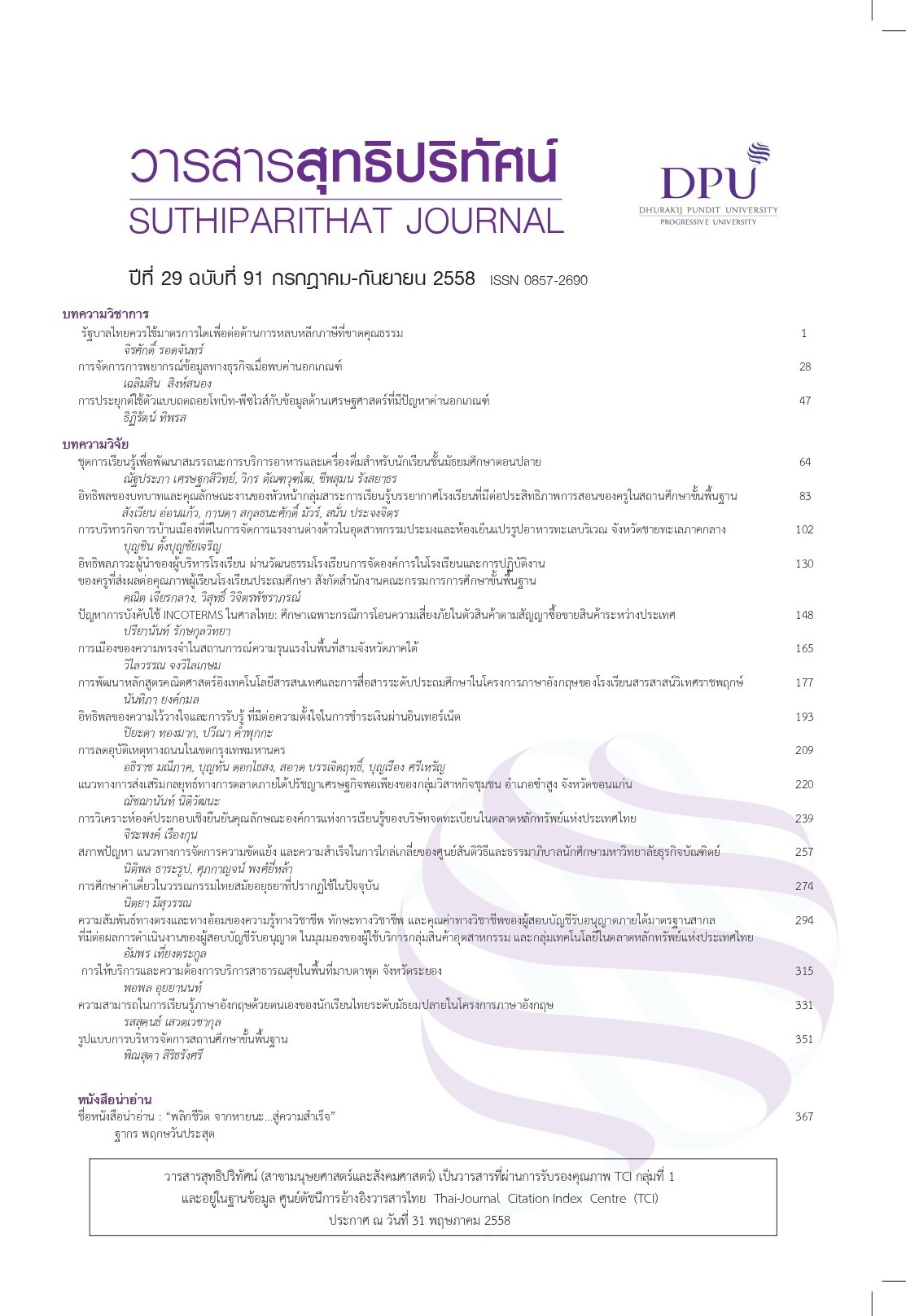ความสามารถในการเรียนรู้ภาษาอังกฤษด้วยตนเองของนักเรียนไทยระดับมัธยมปลายในโครงการภาษาอังกฤษ
คำสำคัญ:
ภาษาอังกฤษ, โครงการภาษาอังกฤษ, มัธยมศึกษาปีที่ 6, ความสามารถในการเรียนรู้ด้วยตนเองนักเรียนไทยบทคัดย่อ
ความสามารถในการเรียนรู้ด้วยตนเองซึ่งนำไปสู่การเรียนรู้ตลอดชีวิตนั้นเป็นแนวคิดที่มี ความสำคัญในระบบการศึกษาไทยเช่นเดียวกับบทบาทของภาษาอังกฤษที่มีความสำคัญในฐานะ ที่เป็นเครื่องมือเพื่อการสื่อสารระหว่างประเทศ ด้วยเหตุนี้ จึงมีการก่อตั้งโครงการภาษาอังกฤษ หรือ โครงการ EP ในบางโรงเรียนขึ้นมาโดยกระทรวงศึกษาธิการ ในปี พ.ศ. 2538 ดังนั้น งานวิจัยนี้จึง มีวัตถุประสงค์เพื่อเปรียบเทียบความสามารถในการเรียนรู้ภาษาอังกฤษด้วยตนเองของนักเรียน โครงการภาษาอังกฤษ และโครงการปกติ โดยใช้วิธีการวิจัยแบบผสมผสานแบบแผนเชิงอธิบายซึ่ง ใช้วิธีการเก็บข้อมูลที่แตกต่างกัน 2 วิธีเพื่อยืนยัน ตรวจสอบ หรือสนับสนุนข้อค้นพบ ทำการเก็บข้อมูล เชิงปริมาณด้วยแบบสอบถามและข้อมูลเชิงคุณลักษณะด้วยวิธีการสัมภาษณ์แบบกึ่งโครงสร้าง แบบสอบถามที่ใช้วัดระดับความสามารถในการเรียนรู้ด้วยตนเองประกอบด้วยด้านความเต็มใจใน การรับผิดชอบการเรียน ด้านความมั่นใจในการเรียนด้วยตนเอง ด้านแรงจูงใจในการเรียน และ ด้านศักยภาพในการเรียนรู้ด้วยตนเอง ตัวอย่างคือนักเรียนชั้นมัธยมศึกษาปีที่ 6 หรือ เกรด 12 ของโรงเรียนรัฐบาล 3 โรงที่ตั้งอยู่ในเขตกรุงเทพมหานคร โดยทุกโรงเรียนเปิดสอนทั้งโครงการ ภาษาอังกฤษและโครงการปกติ ทำการเลือกโรงเรียนโดยวิธีสุ่มแบบแบ่งกลุ่ม และตัวอย่างคือ นักเรียนจำนวนทั้งหมด 454 คน แบ่งเป็นนักเรียนในโครงการภาษาอังกฤษ 227 คน และโครงการ ปกติ 227 คน
จากการวิเคราะห์ข้อมูลโดยทดสอบค่าที แบบ independent samples พบว่ามีความ แตกต่างอย่างมีนัยสำคัญของความสามารถในการเรียนรู้ภาษาอังกฤษด้วยตนเองของนักเรียนทั้งสอง โครงการ ซึ่งหมายความว่า โดยเฉลี่ย ความสามารถในการเรียนรู้ภาษาอังกฤษด้วยตนเองของ นักเรียนโครงการภาษาอังกฤษสูงกว่านักเรียนในโครงการปกติ ประเด็นที่นำมาอภิปรายผลวิจัย ดังกล่าว คือ “โอกาสได้ใช้ภาษาอังกฤษ” ซึ่งเกิดจาก “การเรียนแบบบูรณาการสาระและภาษา (CLIL)” ซึ่งเป็นรูปแบบเฉพาะของโครงการภาษาอังกฤษมีส่วนในการสร้างโอกาสให้นักเรียนโครงการ ภาษาอังกฤษได้ใช้ภาษาอังกฤษที่กำลังเรียนอยู่ และพบว่าการใช้ประโยชน์จากโอกาสที่ได้รับมีความ สัมพันธ์กับ “การอนุมานสาเหตุความสำเร็จในการเรียนกับความพยายาม” นอกจากนี้ “แรงจูงใจใน การเรียน” มีอิทธิพลอย่างมากต่อระดับความสามารถในการเรียนรู้ด้วยตนเองของนักเรียนโครงการ ภาษาอังกฤษ มีการอภิปรายต่อไปถึงปัจจัยที่ก่อให้เกิดแรงจูงใจสูงในการเรียนภาษาอังกฤษอีกด้วย บทความวิจัยยังเสนอข้อเสนอแนะสำหรับครูผู้สอน ผู้วางนโยบาย และนักวิจัยที่สนใจจะทำการวิจัย ในประเด็นที่เกี่ยวข้องต่อไป
เอกสารอ้างอิง
Banegas, D.L. (2013). The integration of content and language as a driving force in the EFL lesson. In E. Ushioda (Ed.), International Perspectives on Motivation (pp. 82-97). Hampshire: Palgrave Macmillan.
Bax, S. (2010). Researching English Bilingual Education in Thailand, Indonesia and South Korea. Retrieved February 2, 2013 from www.britishcouncil.org/accessenglish
Benson, P. (2001). Teaching and Researching Autonomy in Language Learning. London: Longman.
Benson, P. (2011). Teaching and Researching Autonomy. (2nd ed). Harlow: Pearson.
Benson, P. & Lor, W. (1999). Conceptions of language and language learning. System, 27, 459-472.
Breen, M. & Mann, S. (1997). Shooting arrows at the sum: perspectives on a pedagogy for autonomy. In P.
Benson & P. Voller (Eds.), Autonomy & Independence in Language Learning (pp. 132-149). London: Longman.
Brown, H. (2000). Principles of Language Learning and Teaching. (Fourth edition). New York: Longman.
Diamantopoulos, A. & Siguaw, A.D. (2000). Introducing LISREL: a Guide for the Uninitiated. London: Sage Publications.
Dickinson, L. (1987). Self-Instruction in Language Learning. Cambridge: Cambridge University Press.
Dickinson, L. (1995). Introduction. The Proceedings of Seminar on Self-Access Learning and Learner Independence: A South East Asean Perspective (pp. 1-10). Bangkok: KMITT.
Gao, X. (2013). Motivated by visions: stories from Chinese contexts. In E. Ushioda (Ed.), International Perspectives on Motivation (pp. 176-191). Hampshire: Palgrave Macmillan.
Holec, H. (1981). Autonomy and Foreign Language Learning. Oxford: Pergamon.
Hsieh, P.H. (2012). Attribution: looking back and ahead at the ‘why’ theory. In S. Mercer, S. Ryan and M. Williams (Eds.), Psychology for Language Learning (pp. 90-102). Hampshire: Palgrave Macmillan.
Knowles, M. (1975). Self-Directed Learning: a Guide for Learners and Teachers. Chicago: Association Press Follett.
Lamb, M. & Budiyanto. (2013). Cultural challenges, identity and motivation in state school EFL. In E. Ushioda (Ed.), International Perspectives on Motivation (pp. 18-34). Hampshire: Palgrave Macmillan.
Little, D. (1990). Autonomy in language learning. In I. Gathercole (Ed.), Autonomy in Language Learning (pp. 7-15). London: CILT.
Littlewood, W. (1996). “Autonomy”: an anatomy and a framework. System, 24 (4), 427-435.
Office of the National Education Commission. (2003). National Education Plan: Revised Edition (B.E. 2002-2016).
(In-Thai). Bangkok: Prikwan Graphic, Co., Ltd. Office of the Education Council. (2010). National Education Act B.E. 2542 (1999). Retrieved June 8, 2013 from http://www.onesqa.or.th/en/publication/nation_edbook.pdf
Pemberton, R. & Cooker, L. (2012). Self-Directed Learning: Concepts, Practice, and a Novel Research Methodology. In S. Mercer, S. Ryan and M.
Williams (Eds.), Psychology for Language Learning (pp. 203-219). Hampshire: Palgrave Macmillan.
Ryan, S. & Mercer, S. (2012). Implicit theories: language learning mind-sets. In S.
Mercer, S. Ryan and M. Williams (Eds.), Psychology for Language Learning (pp. 74-89). Hampshire: Palgrave Macmillan.
Scharle, A. & Szabo A. (2000). Learner Autonomy: a Guide to Developing Learner Responsibility. Cambridge: Cambridge University Press.
Sinclair, B. (1996). Materials design for the promotion of learner autonomy: how explicit is ‘explicit’? In R. Pemberton, E. Li, W. Or, and H. Pierson
(Eds.), Taking Control: Autonomy in Language Learning (pp. 149-165). Hong Kong: Hong Kong University Press.
Spratt, M., Humphreys, G., & Chan, V. (2002). Autonomy and motivation: which comes first? Language Teaching Research, 6(3), 245-266.
Swatevacharkul, R. (2009). An Investigation on Readiness for Learner Autonomy, Approaches to Learning of Tertiary Students and the Roles of English
Language Teachers in Enhancing Learner Autonomy in Higher Education. Unpublished research report. Dhurakij Pundit University.
Swatevacharkul, R. (in press). Readiness for learner autonomy on English learning of Mattayom Suksa 6 students. Journal of Education Naresuan University. The Educational Innovation Development Commission. (2011). English Program. (In-Thai).Retrieved August 15, 2014 from http://www.moe.go.th/5TypeSchool/school_eng_next.htm
Ushioda, E. (1996). Learner Autonomy 5: The Role of Motivation. Dublin: Authentik.
Weiner, B. (1986). An Attribution Theory of Motivation and Emotion. New York: Springer-Verlag.
Wenden, A. (1987). Conceptual background and utility. In A. Wenden & J. Rubin (Eds.), Learner Strategies in Language Learning (pp. 3-13). Hertfordhire: Prentice Hall International.
Wenden, A. (1991). Learner Strategies for Learner Autonomy: Planning and Implementing Learner Training for Language Learners. Hertfordshire: Prentice Hall International.
Williams, M. & Burden, R. (1999). Students’ development conceptions of themselves as language learners. The Modern Language Journal, 83, 193-201.
Wolff, D. (2003). Content and language integrated learning: a framework for the development of learner autonomy. In D. Little, J. Ridley, and E. Ushioda (Eds.), Learner Autonomy in the Foreign Language Classroom (pp. 211-222). Authentik.
ดาวน์โหลด
เผยแพร่แล้ว
รูปแบบการอ้างอิง
ฉบับ
ประเภทบทความ
สัญญาอนุญาต
เนื้อหาและข้อมูลในบทความที่ลงตีพิมพ์ในวารสารสุทธิปริทัศน์ ถือเป็นข้อคิดเห็นและความรับผิดชอบของผู้เขียนบทความโดยตรงซึ่งกองบรรณาธิการวารสาร ไม่จำเป็นต้องเห็นด้วย หรือร่วมรับผิดชอบใด ๆ
บทความ ข้อมูล เนื้อหา รูปภาพ ฯลฯ ที่ได้รับการตีพิมพ์ในวารสารสุทธิปริทัศน์ ถือเป็นลิขสิทธิ์ของวารสารสุทธิปริทัศน์หากบุคคลหรือหน่วยงานใดต้องการนำทั้งหมดหรือส่วนหนึ่งส่วนใดไปเผยแพร่ต่อหรือเพื่อกระทำการใด ๆ จะต้องได้รับอนุญาตเป็นลายลักษณ์อักษรจากวารสารสุทธิปริทัศน์ก่อนเท่านั้น







